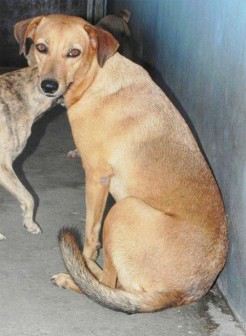Continued from last week
Before we continue, as promised, with the discussion on different types of breathing, allow me to mention a few more conditions (see last week’s TPC) which can contribute to respiratory diseases.
Overcrowding, often associated with poor hygienic conditions, and resultant stress increase both the possibility of infection and the severity of disease signs. Such conditions that favour the spread of infections may occur in some catteries, kennels, pet shops, boarding facilities, humane shelters, etc.

Now, you remember that last week we began discussing abnormal types of breathing, as we made the distinction between ‘rapid breathing’ (abnormal) and ‘panting’ (the normal process by which the dog lowers its body temperature). Let’s look at some other abnormalities associated with breathing in (inhalation) and breathing out (exhalation).
Wheezing
A wheezing is the whistling sound that one hears when a dog under respiratory distress inhales and exhales. Usually, this whistling sound is associated with a constriction of the windpipe (trachea) or bronchial tubes. Sometimes the sounds are not quite audible, but if one were to place one’s ear on the side of the rib cage, the wheezes are quite distinctly heard. The narrowing of the airways to which I referred, can also be caused by tumours or growths in those areas. Moreover, any long term lung or heart disease would result in the wheezing sounds later on.

In some breeds, wheezing and noisy breathing are especially pronounced. Those dogs with the short snouts (you know, the ones that look as if they ran into a wall, mouth first), eg, Bulldogs, Pekinese, Pugs and even Boxers, often exhibit wheezing sounds, even snoring and snorting. The airway obstruction which leads to these sounds was actually created when the breeders of yore decided it would be cute to produce dogs with mashed-in faces. In creating these faces, the area of the soft palate became proportionally enlarged; this, in turn, partially blocks the opening into the voice box. The poor dog now has to live with this man-made malady (all in the name of ‘cuteness,’ even though ‘vanity’ might be the more appropriate term).
The wheezing/snorting or croupy breathing becomes more audible when the animal undergoes excessive physical stress or when the environment is extremely hot. Also, as the dog becomes older, the condition is exaggerated. The animal often begins to breathe through the mouth, especially if the nostrils collapse (as can happen in the breeds with ‘pushed-in’ faces).
Of course, if a dog has distemper and the nostrils are pasted/blocked up with purulent (pus) discharge, the laboured breathing will be accompanied by a wheezing sound. Similarly, ailments like laryngitis or kennel cough or spasms of the larynx or bronchitis or asthma, etc, (in fact, any malady that affects the breathing tubes), will result in abnormal breathing with varying degrees of accompanying noise, as the animal inhales and exhales. We will deal with these specific ailments in more detail next week.
Shallow
breathing
I should mention that there are certain conditions, which restrict the movement of the rib cage. If the dog is feeling pain (eg, as with a rib fracture or a severe bronchitis) as he breathes in and out, he tends to breathe less deeply (shallow breathing). Fluid in the chest (blood in the chest cavity, for example) would cause restricted, shallow breathing. Just before a dog expires, the breathing becomes extremely shallow.
Please implement disease preventative measures (vaccinations, routine dewormings, monthly anti-heartworm medication, etc) and adopt-a-pet from the GSPCA’s Animal Clinic and Shelter at Robb Street and Orange Walk, if you have the wherewithal to care well for the animals. Do not stray your unwanted pets, take them to the GSPCA’s Clinic and Shelter instead. If you do not wish your pet to have puppies or kittens, you may exploit the GSPCA’s free spay and neutering programme. If you see anyone being cruel to an animal, or if you need any technical information, please get in touch with the Clinic and Shelter by calling 226-4237.





